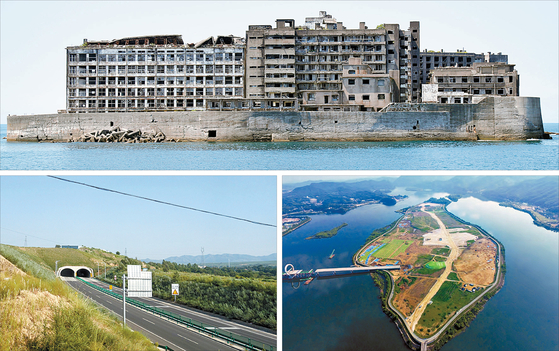The tripolar Unesco World Heritage race

Kang In-uk
The author is a professor of history at Kyung Hee University.
Korea has many historic remains across the country. Among them, the Unesco World Heritage Sites attract a great deal of attention. Though the listing system was introduced only 45 years ago, those sites carry great significance. Korea is no exception. After departments and divisions handling the registration and preservation issues were established in the Cultural Heritage Administration (CHA) and other local government organizations, Koreans have started to wonder what other places have ascended to the pedestal that is Unesco World Heritage each year. Here is a look at the origins of the World Heritage Sites and Koreans’ interest in their cultural legacy.
The World Heritage Sites are divided into Cultural, Natural and Mixed (both Cultural and Natural) categories. Cultural Heritage, in particular, is called World Heritage. As of 2023, there are 1,199 World Heritage sites around the globe. Their registration and conservation is a primary item of business for the UN body.
The World Heritage Sites program was not intended to encourage each country to boast about their cultural assets, but rather designed to protect each country’s cultural legacies beyond their national identity. The program started with the Nile Basin, the cradle of the ancient Egyptian civilization. Even now, 97 percent of all Egyptians live in the regions along the Nile.
The problem there was a chronic shortage of water. To solve it, Egypt built the Aswan Dam in 1970, but at the risk of drowning magnificent sites such as the Abu Simbel temple. More than 50 countries, including Korea, launched an international fund-raising program to relocate the historic site famous for the four spectacular statues of Ramses erected in front of the main temple. Shortly after the successful relocation, an international proposal was made to jointly protect renowned cultural heritages around the world. Egypt suffered the most from the West’s pillage and destruction of its marvelous architecture following Napoleon’s invasion of the country in 1798.
West Europe has the largest number — nearly half — of World Heritage sites. Citing obvious economic restrictions from the registration of their sites, many Europeans even pleaded with their government to lift the registration.

The World Heritage system centered around Europe began to change in the 1990s after East Asian countries vied to register their historic sites following their economic growth. The most aggressive was by China, with 57 World Heritage Sites now, only second to Italy with 59. Given China’s relatively rich cultural heritage, its systematic management of the registration process, and enormous budget, the likelihood of China successfully posting its cultural assets on the Unesco list is quite high. Currently, Korea has 16 World Heritage sites. After the Seokgulam Grotto and the Bulguksa Temple were listed as World Heritage sites in 1995, a number of municipal governments have been racing to place their cultural legacies on the list.
Heated international attention also fueled diplomatic disputes as exemplified by the conflict between South Korea and China over Goguryeo (37 B.C. to A.D. 668) history. After China tried to put the tombs and ruins of the ancient Korean kingdom in Manchuria as its own on the Heritage list, North Korea strongly protested. The dispute ended up with North Korea and China separately registering the Goguryeo remains on the World Heritage list. After the Old City of Hebron in the West Bank was posted as Palestine’s World Heritage site in 2017, the United States, the world’s largest donor to Unesco, and Israel once left the UN body in tandem in defiance of the decision. (The U.S. was readmitted to Unesco in July 2023 during the Biden administration.)
Japan is still bent on justifying its “selective memories” after erasing its shameful past by means of the Heritage program, as clearly seen in its registration in 2015 of the controversial Hashima Island, or “Battleship Island,” as a World Heritage site, citing its contribution to Japan’s industrial development during the Meiji Restoration. At the time, Unesco attached the condition that Japan must specify its past wrongdoings, including the forced labor in the underground coal mine in a tiny island off Nagasaki. But Japan deleted the tricky part and successfully put the island on the World Heritage list, provoking vehement opposition from other countries.
Japan did not stop there. In 2022, when it applied for the registration of the Sado mine in Niigata Prefecture as a World Heritage site, it skipped a description about Koreans’ forced labor to provoke controversy again. Japan is even seeking World Heritage recognition for the farewell letters from kamikaze pilots during World War II, praising their value as a reminder of the tragedy enforced on individuals by the state. But if Japan’s bid succeeds, Nazi solders’ diaries in the battlefields also can be included in the World Heritage Committee’s trove of treasured documents. Such alarming developments shake the spirit of the World Heritage.
Korea is moving fast to register its historic sites, too. As the trend of designating a set of historic remains — instead of a single one — gains traction, it is easier to see them around you. For instance, the Baekje (18 B.C. to A.D. 660) Remains District now encompass Seoul, Buyeo and Gongju in South Chungcheong, and Iksan, North Jeolla. The Gaya confederacy (42 A.D. to 532 A.D.) and seowon, a type of neo-Confucian academy during the Joseon Dynasty (1392 to 1910), are also expanding in their territory and scope. Such a trend is nothing new for China. Beijing is preparing to get its Central Axis — which stretches over a distance of 7.8 kilometers (4.8 miles) — recognized as a World Heritage site next year, even though the city has seven Heritage sites already.
The biggest reason that our municipal governments push for the World Heritage Sites is to get more tourists. However, as the number of Heritage sites increases, their scarcity value diminishes. Rather than seeking to place more sites on the list, governments, big or small, need to conduct a careful cost-benefit analysis.
After a new apartment complex blocked the view of a Joseon Dynasty royal tomb, which had been designated as a World Heritage site, the Cultural Heritage Administration filed a suit against the constructor. The CHA is waiting for a final ruling from the Supreme Court after being defeated in the first and second trials. Another controversy involves damages on historic remains from economic development. In the site for the Legoland theme park in Jungdo Island in Chuncheon City, Gangwon, more than 1,300 dwelling spots and over 150 dolmens were discovered — the largest number of prehistoric remains in Korea. But after the excavation by the heritage administration was over, the theme park opened.
In the meantime, the prehistoric ruins in the Sannai-Maruyama Site in northern Japan — which has a similar size to the site for the Legoland theme park — was listed as a World Heritage site in 2021. The Yoshinogari Site in Saga Prefecture, Kyushu — or the ruins of a large settlement during the Yayoi Period, which is compatible to Korea’s Bronze Age — has become an icon of international archeological research after building a relics park instead of developing the site.
China is also very strict about preserving historic remains. In 2008, ruins of an ancient fortress representing the Lower Xiajiadian culture (2200 B.C. to 1600 B.C.) of the early Bronze Age were discovered around the upstream of Liaohe River during a highway construction in western Manchuria. As hundreds of fortress ruins had been discovered in the region, China was expected to excavate the newly discovered ruins and move on to build the highway there.
But China instead dug a tunnel under the ruins to preserve the remains discovered on a swath of land one-fourth the size of Korea’s Legoland. Compared to China, Korea’s reality is poor, indeed. “Even if China uncovers ancient tombs of the Goguryeo Dynasty in Jian [an old capital of Goguryeo] in Manchuria, we have nothing to say,” a Korean scholar lamented.
Unesco has been devoted to the promotion of education and culture since World War II. Its most successful program so far has been to preserve historic sites around the globe. International interest in its World Heritage Sites continues to grow, but cases of political exploitation also proliferate, not to mention the simmering conflict between preservation and development.
We should look back at what we have been doing. We must question if we are only engrossed in putting our historic sites on the Unesco list. The time has come for Koreans to reflect on the genuine meaning of World Heritage Sites whether they be cultural, natural or mixed.
Translation by the Korea JoongAng Daily staff.










with the Korea JoongAng Daily
To write comments, please log in to one of the accounts.
Standards Board Policy (0/250자)